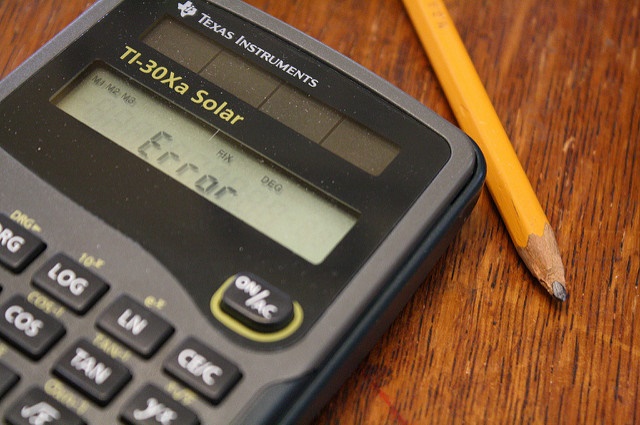
Flickr user Tim Taylor
While the new SAT math section can be many students’ nightmare, it is the writing section that other students dread the most. The SAT writing section is meant to test and challenge your practical editing skills. All you need to know is how to read and how to find and fix grammatical errors and structural problems. This sounds straightforward enough for anyone who has acquired strong language skills writing papers throughout their school years. Most schools routinely give students these kinds of assignments in class and also as homework. So why is it that students find the writing section so daunting?
The SAT writing section is very different.
The biggest challenge with the new SAT writing section is that it is completely different from any other writing test you would have done in school. The questions are structured in such a way that they are meant to confuse any test taker who is careless. The questions by themselves are easy but the way they are asked will trip you up if you are not careful.
Love it or hate it, you have no choice but to learn the tricks to answering the SAT writing section in order to ace the test. Your test scores are one of the major factors that will determine which college you get admission into.
Knowing the common mistakes that students make when answering the writing section will help you get a better idea of what pitfalls you need to look out for and how to avoid them.
Interpreting Questions Incorrectly
Time is a crucial factor in any standardized test. You have very little time in which to answer a whole lot of questions. The only problem with this is many students rush through the questions and end up interpreting them wrong. Remember, these questions are not always straightforward. They are designed to be tricky, which means you need to take a few extra seconds to understand exactly what is being asked.
Students may read a question so fast that before they have the time to process the information, they have already jotted down the answer, little knowing that they have missed an essential catchphrase or keyword embedded within the question.
Some words change the entire meaning of the sentence so it’s best that you calm down and take it slow. Read the question properly so you are not making any questions. If there is the slightest confusion in your mind as to what the question is asking, read through it again. Better to spend that extra time re-reading the question than to answer it wrongly.
Underline or circle the keyword that defines the question and see that you give a response fitting enough to answer their query and not reply to the one you have formulated yourself.
Grammar Rules Gone Wrong
You would expect that anybody who converses in English on a daily basis will be familiar with the standard rules of the language. However, even native English speakers tend to mess up the grammar, especially since many of us speak the language casually without being mindful about the small nuances of the languages.
No matter how fluent you are with speaking and writing the language it is still a good idea to brush up on grammar rules before you go for the test. Pay special attention to grammatical concepts. Learn to recognize and tell the difference between nouns, pronouns, prepositions, and gerunds. It’s surprising how many students lose marks for simple mistakes that could have been easily avoided.
The best way to master your grammar skills is by taking online practice tests and checking out the concepts you fumble with. It’s not enough to merely check your score. Make sure to go through the correct answers so that you learn the right concepts.
Jumping To Main Passages To Save Time
In most questions, you are asked to find grammatical errors in a passage. Many students simply skim read through the passages and jump right to the main underlined passages. This is a mistake and beats the entire purpose of the test. Since many questions comprise of Command of Evidence questions, it is imperative to understand the basic structure of the passage.
Remember, a majority of the questions will want you to understand the entire passage so you can identify the introductory or concluding sentence of the passage or add an additional sentence anywhere in the passage. You need to think out of the box and pay close attention. Think of these as mind games and get into that mode. Take time to understand the entire passage and grasp the main idea and objectives of the passage. Read the instructions again to see exactly what is expected of you. When it comes to answering these tricky questions, do not assume anything.
Do Not Over Think It
Like all things in life, even when it comes to the SAT writing section, you should listen to your instincts. Learn to trust and follow them. Don’t get so wound up that you over analyze any question. Over thinking any particular question will not only decrease the accuracy of the answer, but it will also waste precious time.
Sometimes, the answer is so obvious, all you need to do is slow down and stay focused and you will see it. Think back to your practice papers and imagine what you would have done during those times.
If you begin to feel overwhelmed and stressed, take a few deep breaths and remind yourself that you are prepared for the test and you will own it regardless of what happens.
Not Practicing Enough
There is a difference between confidence and overconfidence, always aim for the former. SAT tests put your practical skills to the test. Each passage is filled with intricacies and difficult-to-detect setbacks that can add to the challenges. It is only through practice sessions and trial and error will you be able to understand these nuances.
The single best advice you can get regarding the different ways to study for SAT test is to take as many practice tests as you can. The more practice tests you take, the more mastery you will have over the various sections. This will help calm your nerves and score high marks on the real test.
Use College Raptor to discover personalized college matches, cost estimates, acceptance odds, and potential financial aid for schools around the US—for FREE!





